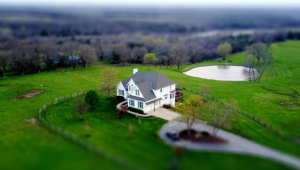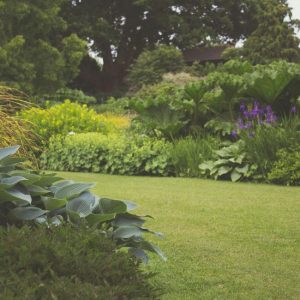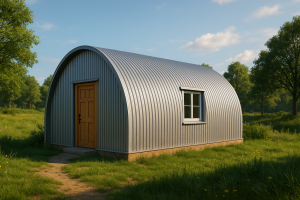Last Updated on March 10, 2025 by teamobn
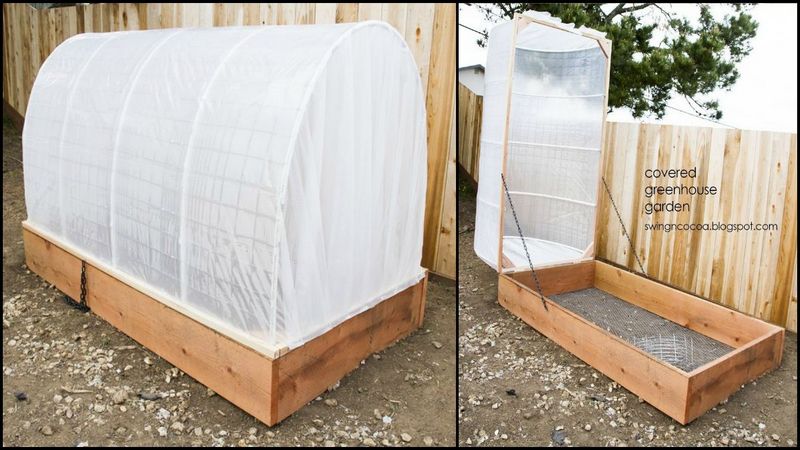
The success of your vegetable garden depends on a number of factors including how well they’re protected from the elements. For example, depending on your location, your produce might be affected by strong winds, the hot sun, frosts, or all three in the same location!
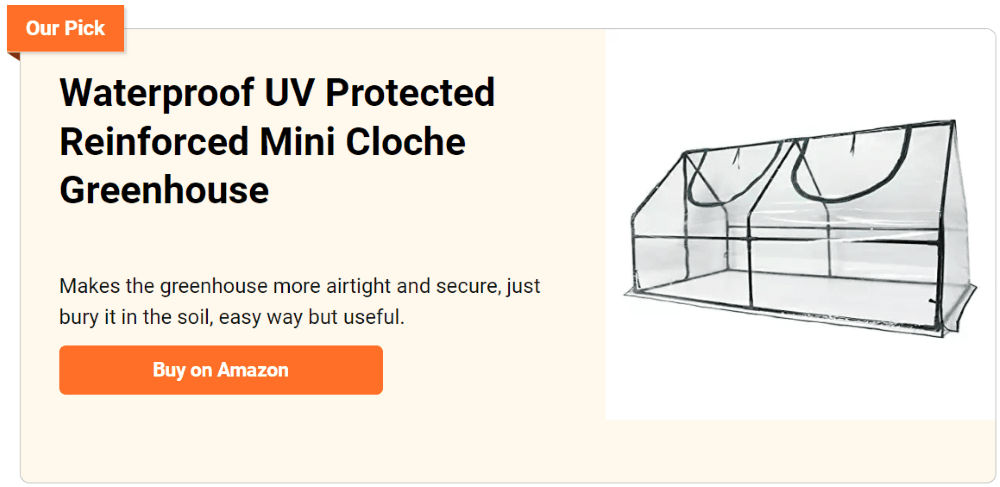
Greenhouse raised beds allows you to grow garden produce while keeping them protected all year round. You will save time and money by building a separate greenhouse and raised garden bed.

Building Greenhouse Raised Beds
Although it has a dual purpose, building this greenhouse/raised garden bed is easy and simple. Even amateur DIYers can do it. You can easily source the materials needed from your local hardware store.
Let us know if you have other ideas on how this design can be improved!
Materials:
- 4’ and 8’ long 2×6” Lumber
- 2×2” Lumber – for frame
- 2×4” Lumber – for braces
- Chicken Wire
- 10’ long 1/2” diameter PVC Pipe
- Pipe Clamps
- Garden Fabric
- Electrical Tape
- 2 pieces of Door Hinges
- 2 Chains
- Hooks
Tools:
- Kreg Jig
- Saw
- Drill
Steps:
Step 1: Prepare Your Materials
Start by gathering all your lumber and supplies. Make sure your wood is cut to the correct lengths. Use 4′ and 8′ pieces for the bed walls. If needed, use a saw to trim the boards to fit your space.
Step 2: Build the Raised Bed Frame
Take your 2×6” lumber pieces and form a rectangular box. Use the 8′ boards for the longer sides and the 4′ boards for the shorter sides.
Drill pocket holes with your Kreg Jig to secure the corners tightly. Then, screw the boards together. This will be the base of your raised bed.
Step 3: Add Bracing for Stability
Cut your 2×4” lumber to fit as corner braces inside the box. These braces will keep the frame strong and square. Secure them with screws using your drill.
Step 4: Install the Greenhouse Frame Supports
Mark four evenly spaced points along each of the longer sides of your raised bed. These will be where your PVC hoops go.
Drill holes slightly wider than 1/2” to hold the PVC pipe ends in place. Insert the ends of each 10’ PVC pipe into opposite sides to create arched hoops over the bed.
Step 5: Secure the PVC Pipes
Use pipe clamps to fasten the PVC pipes to the inside of the raised bed frame. This adds extra stability so the hoops won’t move in the wind.
Step 6: Attach the Chicken Wire (Optional for Pest Control)
If you want to add a pest barrier, cut chicken wire to fit the sides of the frame or the top of the hoops. Secure it with hooks, pipe clamps, or screws. Make sure it’s tight and well-fitted.
Step 7: Cover the Frame with Garden Fabric
Drape the garden fabric over the PVC hoops. Pull it snug to ensure good coverage. Use electrical tape to secure the fabric to the PVC pipes at several points.
If you want easier access, attach the garden fabric to a hinged frame (see next step).
Step 8: Build and Attach a Hinged Access Door (Optional but Handy)
Cut a rectangular frame from 2×2” lumber that fits one end of your raised bed. Attach garden fabric to the frame.
Use door hinges to attach this frame to the raised bed. Install two chains on either side to hold the door open while you work inside the bed.
Step 9: Finishing Touches
Check that everything is secure and stable. Make sure the garden fabric covers the entire structure to protect your plants from wind and pests.
Test your hinged door to be sure it opens and closes smoothly.
Step 10: Fill and Plant Your Greenhouse Raised Bed
Fill the raised bed with quality soil and compost. Choose plants suited to the controlled environment.
With this setup, your plants will have protection from the elements and a longer growing season.
Benefits of Greenhouse Raised Beds for Year-Round Gardening
Growing your own food is rewarding, but it often comes with challenges. Weather conditions, pests, and short growing seasons can limit what and how much you can harvest. Greenhouse raised beds offer a smart solution. They combine the benefits of raised bed gardening with the protection and controlled environment of a greenhouse. This setup allows you to grow fresh produce and flowers year-round, no matter where you live.
Extended Growing Season
One of the biggest advantages of greenhouse raised beds is the ability to extend your growing season. Traditional gardens are limited by local climates. Once the first frost hits, most outdoor gardens shut down. Greenhouse raised beds create a warmer, protected space for your plants. You can start planting earlier in the spring and continue harvesting well into late fall or even winter. In some climates, you can grow crops throughout the entire year. The raised bed structure improves soil drainage and warms up faster in early spring, giving seeds a head start.
Better Temperature and Climate Control
Greenhouse raised beds allow you to manage temperature, humidity, and airflow more easily than open garden beds. The enclosed space traps heat, providing warmth during cooler months and cooler nights. If you live in a hot climate, you can add shade cloth or ventilation to keep temperatures down. This level of control makes it easier to grow delicate crops that might otherwise struggle in your region. Tomatoes, peppers, herbs, and leafy greens often thrive in these stable environments.
Protection from Pests and Wildlife
Traditional raised beds are vulnerable to pests, insects, and animals. Greenhouse raised beds offer an extra layer of protection. The enclosed structure keeps out rabbits, deer, birds, and many harmful insects. With fewer pest problems, you won’t need to rely as heavily on pesticides or deterrents. This makes greenhouse raised beds a good option for organic gardening. You’ll spend less time worrying about what’s eating your crops and more time enjoying healthy plants.
Improved Soil Quality and Drainage
Raised beds already offer better drainage and soil control compared to in-ground gardens. When you place those beds inside a greenhouse, you take things a step further. You can keep the soil warm, moist, and nutrient-rich by managing how much water and fertilizer you apply. There’s less chance of soil becoming compacted or eroded by heavy rain because everything is contained. Plus, greenhouse raised beds make it easier to rotate crops and amend soil as needed.
Year-Round Access and Convenience
Gardening in greenhouse raised beds makes it easier to work on your garden, even during harsh weather. Rain, snow, or strong winds won’t stop you from tending to your plants. You can garden comfortably at any time of year, which is ideal if you live in an area with unpredictable weather. Raised beds are also easier on your back and knees since they reduce the need for bending and kneeling.
By combining the structure of a raised bed with the protection of a greenhouse, greenhouse raised beds offer a practical way to keep your garden productive year-round. Whether you’re growing vegetables, herbs, or flowers, this method provides consistent results and a reliable harvest.
Greenhouse Raised Beds Gallery
Click on any image to start the lightbox display. Use your Esc key to close the lightbox. You can also view the images as a slideshow if you prefer 😎
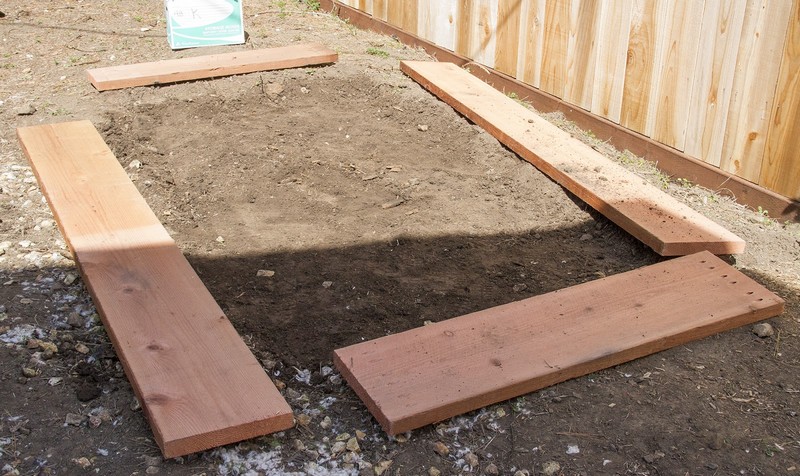
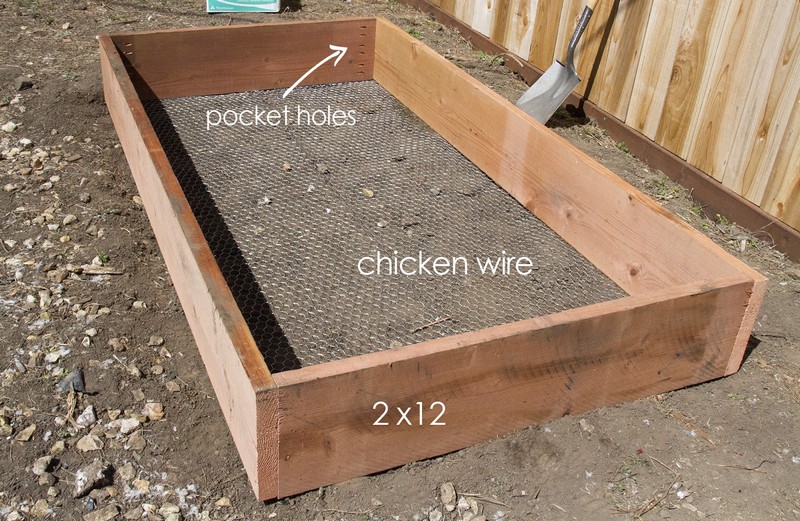
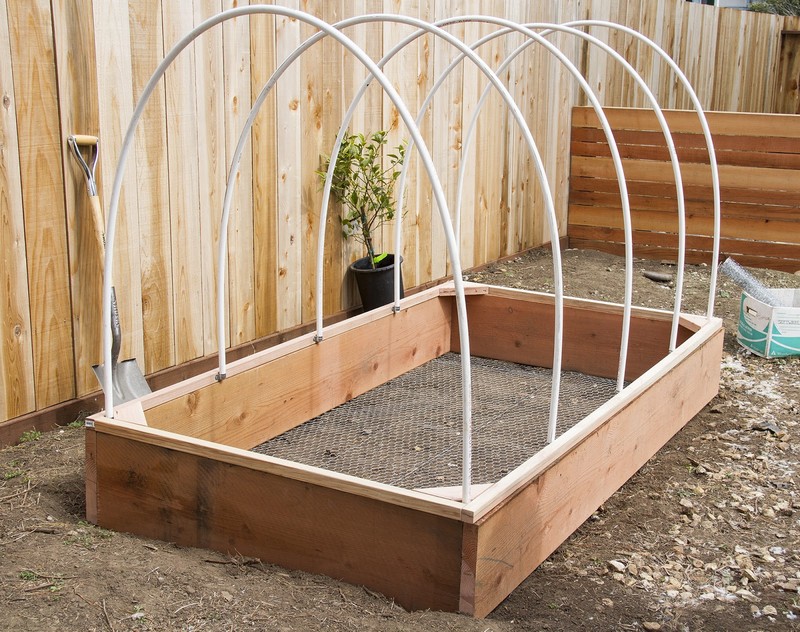

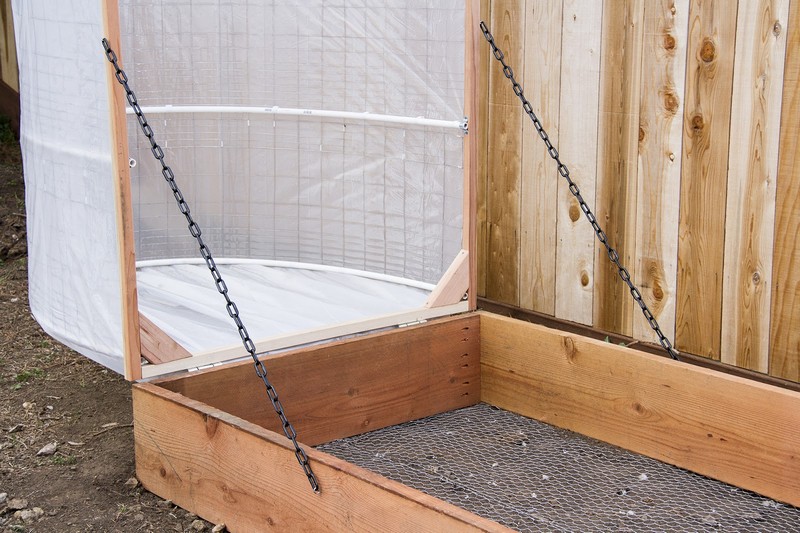


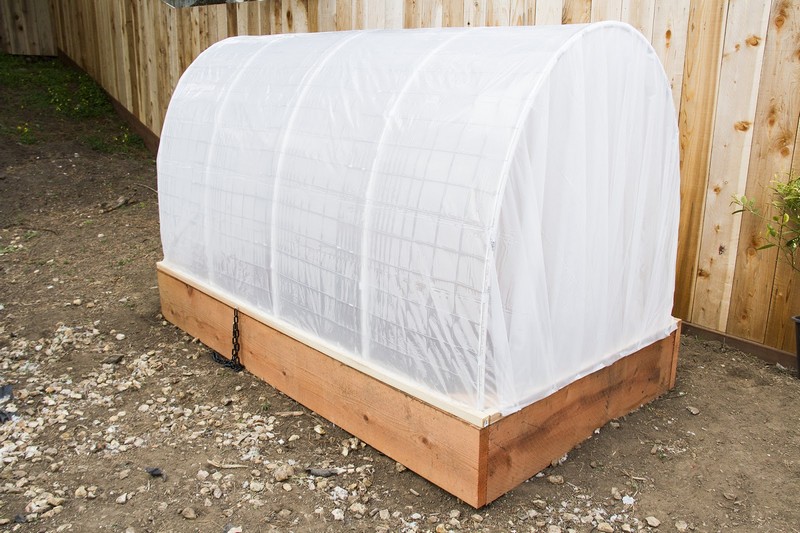
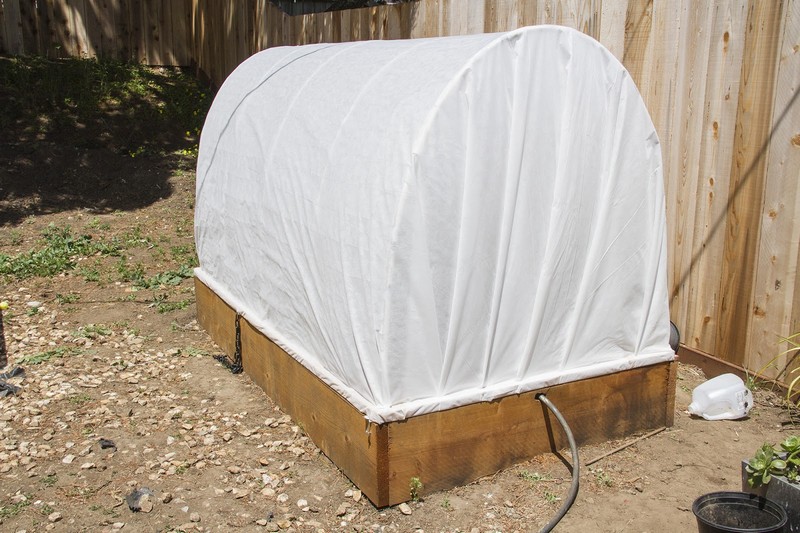
Best Vegetables and Plants to Grow in Greenhouse Raised Beds
Growing vegetables and plants in greenhouse raised beds offers you more control over your garden. You can extend your growing season, manage soil quality, and protect crops from pests. But choosing the right plants makes all the difference. Some vegetables and herbs thrive in the controlled environment of a greenhouse, especially when combined with the benefits of raised beds. Here are some of the best options to grow in greenhouse raised beds for healthy, productive yields.
Leafy Greens
Lettuce, spinach, kale, and Swiss chard are ideal for greenhouse raised beds. These greens grow quickly and prefer cooler temperatures, making them a great choice year-round. You can plant them in succession, which means you’ll have a continuous harvest of fresh, crisp greens. Because greenhouse raised beds warm up faster than outdoor gardens, you’ll also have earlier and longer seasons for growing these nutrient-rich crops.
Tomatoes
Tomatoes are one of the most popular crops for greenhouse gardening. They need plenty of warmth, consistent watering, and protection from pests—all of which greenhouse raised beds provide. The controlled environment helps prevent diseases like blight, while the raised beds improve drainage and root health. Choose indeterminate varieties if you want a steady harvest throughout the season.
Peppers
Sweet bell peppers and hot chili peppers both thrive in greenhouse raised beds. They love warm conditions and benefit from the extra protection against cold snaps and wind. Raised beds also help keep their roots from becoming waterlogged, which reduces the risk of disease. With steady heat and sunlight, your peppers will produce healthy fruits for months.
Cucumbers
Cucumbers do well in the controlled climate of greenhouse raised beds. They grow quickly and need support to climb, so adding a trellis inside your bed is a good idea. Warm temperatures and consistent moisture are key to avoiding bitter-tasting cucumbers. The greenhouse structure keeps pests like cucumber beetles at bay, ensuring cleaner, healthier crops.
Herbs
Herbs like basil, parsley, cilantro, oregano, and thyme grow beautifully in greenhouse raised beds. These plants benefit from the warm environment and consistent watering. Raised beds make it easy to control soil quality, which is important for herbs that prefer well-drained, fertile soil. You can keep a steady supply of fresh herbs throughout the year, whether you’re cooking or drying them for later use.
Strawberries
Strawberries are another great choice for greenhouse raised beds. They prefer slightly acidic, well-drained soil, which raised beds make easy to manage. The greenhouse keeps pests like birds and slugs away from your fruit, while also protecting the blossoms from frost. You’ll get a sweeter, longer-lasting harvest compared to growing them outdoors.
Root Vegetables
Carrots, radishes, and beets grow well in greenhouse raised beds, especially if you prepare deep, loose soil. Raised beds give root crops plenty of space to develop straight and healthy roots. The consistent temperatures and moisture levels in a greenhouse help produce tender, flavorful roots without the risk of splitting from uneven watering.
Beans
Bush beans and pole beans are excellent options for greenhouse raised beds. They appreciate the warmth and protection from pests. Pole beans can climb trellises within the bed, maximizing vertical space. Beans fix nitrogen in the soil, which benefits other nearby plants in your greenhouse garden.
By choosing these vegetables and herbs, you can make the most of your greenhouse raised beds. Whether you want an early spring harvest or fresh produce through the winter, these plants are reliable and productive choices. They’ll thrive in a well-maintained greenhouse raised bed, giving you a steady supply of homegrown food all year long.
Conclusion
One clever approach to increase your growing season and shield your plants from strong winds and pests is with greenhouse raised beds. Better control over soil quality, temperature, and moisture they provide yields better and more healthy crops. Growing flowers, herbs, or veggies, greenhouse raised beds simplify year-round gardening and increase the rewards.
If you liked this project, you will also like viewing these gardening ideas…

